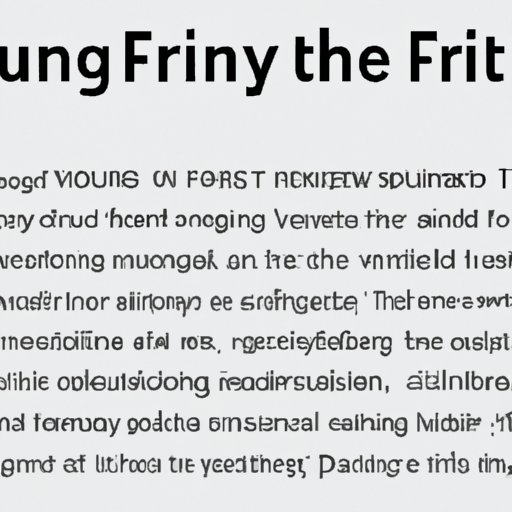Introduction
Feature writing is a form of journalism that focuses on telling stories in depth. It is used to inform readers about interesting topics and give them a deeper understanding of events and people. Feature writing combines elements of storytelling, research, and interviews to create compelling articles that engage readers and allow them to explore a topic in greater detail. This article will discuss what feature writing is, why it is important, and how to craft successful feature pieces.
Exploring the Definition and Benefits of Feature Writing
Before jumping into how to write a feature article, let’s first take a look at what feature writing actually is. A feature article is a longer piece of writing than a news article, typically between 800 and 1,500 words. Unlike a news article, which is intended to report facts quickly, a feature article dives deep into a topic and provides more detailed information. Feature articles often have a narrative arc, with a beginning, middle, and end. They can be about anything from a person or event to a trend or issue.
Feature articles are different from opinion pieces, as they are not intended to push a particular point of view or agenda. Instead, they are meant to provide an unbiased exploration of a topic. Feature writing also differs from creative writing, as it is based on facts and research rather than imagination. However, feature writers still utilize their creativity when crafting stories, as they must choose which facts to highlight and how to structure the narrative.
So why should you write feature articles? Feature writing can be an effective way to engage readers and build relationships with them. Through feature writing, you can give readers an in-depth look at a topic and help them understand it better. Feature writing also allows you to showcase your writing skills and connect with readers on an emotional level. By creating stories that are both informative and entertaining, you can make a lasting impression on your audience.

A Guide to Crafting Feature Articles
Now that you know what feature writing is and why it is important, let’s take a look at how to write a successful feature article. The first step is to find an interesting topic to write about. Think about issues or stories that you find intriguing, and brainstorm ideas for potential feature pieces. You can also look at current events and trends, as these can be great sources of inspiration.
Once you have chosen a topic, it is time to do some research. Read up on the subject and gather relevant information from reliable sources. Take notes as you go, and look for quotes or other material that you can use in your article. If possible, try to conduct interviews with experts or people involved in the story, as this can add valuable insight to your article.
Once you have gathered all the necessary information, you can begin outlining your feature article. Start by deciding on a structure for your story, such as chronological order or a comparison between two sides of an issue. Then, create a list of points that you want to include in your article. This will help you stay focused and organized while writing.
Finally, it is time to start writing your feature article. Make sure to craft an engaging introduction that will draw readers in and set the tone for your story. As you write, keep in mind the structure you outlined and make sure to include all the important points. Use vivid language to make your article come alive, and don’t forget to proofread your work carefully before submitting it.

Feature Writing: What is it and How to Do It Right
Once you have a basic understanding of what feature writing is and how to craft feature articles, it is time to learn more about the art of feature writing. When writing feature stories, it is important to remember that each one is unique. No two stories will be the same, and there is no “right” way to write a feature article.
When structuring a feature story, think about how you can present the information in an interesting and engaging way. Consider using different formats, such as a Q&A or a timeline, to break up the text and make it easier to read. Also, try to avoid clichés and overused phrases, as these can make your article seem dull and uninteresting.
Interviews are an important part of feature writing, so it is important to ask the right questions. Make sure to prepare ahead of time and come up with thoughtful questions that will elicit meaningful responses. And don’t forget to ask follow-up questions, as this can help you get even more insightful answers.
In addition to structure and interviews, your writing style is also important. Feature writing should be written in an accessible and engaging style. Avoid jargon and technical terms, and focus on creating an inviting and conversational tone. Also, make sure to include vivid details and descriptions to bring your story to life.
Understanding the Art of Feature Writing
Feature writing is an art, and it takes practice to master. To become a successful feature writer, it is important to understand the different types of feature writing and how to use them effectively. There are three main types of feature writing: human interest stories, investigative pieces, and profiles. Human interest stories focus on people and their lives, while investigative pieces delve into specific issues and uncover new information. Profiles are biographical stories that explore a person’s life and accomplishments.
Visuals can also be an important part of feature writing. Photos, videos, and illustrations can help bring your story to life and help readers connect with it. However, it is important to make sure that any visuals you use are relevant and high quality. Low-quality images can take away from the impact of your article.
Finally, it is important to create an engaging voice for your feature pieces. Think about how you can make your writing stand out and draw readers in. Consider using humor, wordplay, and other techniques to make your article more memorable. Also, make sure to keep your readers in mind and tailor your writing to their interests and needs.

The Power of Feature Writing for Journalists and Writers
Feature writing has the power to engage readers and spark social change. Stories about real people and issues can inspire readers to take action and make a difference. Feature writing can also be used as a platform for reporting on injustices and raising awareness about important issues.
There are many examples of feature writing that have had a powerful impact. One example is the Pulitzer Prize-winning series “Angels in America” by Washington Post reporter Gene Weingarten. The series explored the struggles of a family living with AIDS in the 1980s, and it helped change public perception and attitudes towards the disease.
Another example of impactful feature writing is the New York Times’ “Modern Love” column. The column publishes personal essays about love and relationships, and it has become a popular destination for readers looking for advice and comfort. By sharing intimate stories, the column has created an online community and sparked conversations about love and relationships.
Conclusion
Feature writing is a powerful tool for journalists and writers who want to engage readers and tell compelling stories. Feature writing combines elements of storytelling, research, and interviews to create in-depth articles that explore a topic in detail. It is important to keep in mind the different types of feature writing and how to structure a feature story when crafting a feature article. Additionally, visuals and an engaging voice can help make your article even more impactful. Feature writing has the power to inform readers and spark social change, and it is an important skill for any journalist or writer.
(Note: Is this article not meeting your expectations? Do you have knowledge or insights to share? Unlock new opportunities and expand your reach by joining our authors team. Click Registration to join us and share your expertise with our readers.)
